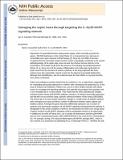Salvaging the septic heart through targeting the IL-6/p38 MAPK signaling network
Author(s)
Cannell, Ian G.; Yaffe, Michael B
Downloadnihms-463056.pdf (23.80Kb)
OPEN_ACCESS_POLICY
Open Access Policy
Creative Commons Attribution-Noncommercial-Share Alike
Terms of use
Metadata
Show full item recordAbstract
Depression of myocardial function during severe sepsis, which currently accounts for approx. 200,000 deaths/year in the United States (1), is characterized by a decrease in contractility and a poor response to fluid therapy (2). Since the md-1980s it has been recognized that the decreased cardiac function, which undoubtedly contributes to the overall pathophysiology of the septic state, does not arise from factors that are intrinsic to the myocardium, but instead results from the presence of circulating myocardial depressant factors (3, 4). Since much of the massive inflammation and multi-organ dysfunction in sepsis result from the secretion of various cytokines, it was long suspected that these proteins were also responsible, at least in part, for the observed myocardial dysfunction, although their identification, and the molecular basis for their effects on myocyte function were poorly understood.
Date issued
2011-07Department
Massachusetts Institute of Technology. Department of Biological EngineeringJournal
Critical Care Medicine
Publisher
Wolters Kluwer - Lippincott Williams & Wilkins
Citation
Cannell, Ian G., and Michael B. Yaffe. “Salvaging the Septic Heart through Targeting the Interleukin-6/p38 Mitogen-Activated Protein Kinase Signaling Network*.” Critical Care Medicine 39, no. 7 (July 2011): 1836–1837.
Version: Author's final manuscript
ISSN
0090-3493